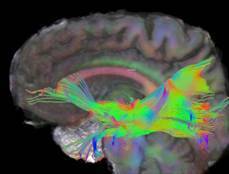by
Nancy Ryerson, Staff Writer | April 04, 2013

A brain tumor with fibers
mediating language in green.
Brain surgeons now have access to a more detailed map of a patient's mind, thanks to diffusion tensor imaging (DTI) and MRI. The technique allows surgeons to visualize white matter tracts in the brain, improving accuracy and potentially protecting brain functions, according to a new review in the journal Neurosurgical Focus.
Researchers at the Perelman School of Medicine at the University of Pennsylvania explored the ways the improved technology of DTI could assist brain surgery. DTI works by measuring the direction that fluid in the brain moves to determine the location of different brain fiber clusters.
"Before, with just an MRI scan, we would just look at the brain as gray matter, white matter and the tumor, and accessing the tumor without touching blood vessels or taking out chunks of brain," senior author Dr. Steven Brem told DOTmed News. "We couldn't see the wiring diagram within the brain."



Ad Statistics
Times Displayed: 132943
Times Visited: 7597 MIT labs, experts in Multi-Vendor component level repair of: MRI Coils, RF amplifiers, Gradient Amplifiers Contrast Media Injectors. System repairs, sub-assembly repairs, component level repairs, refurbish/calibrate. info@mitlabsusa.com/+1 (305) 470-8013
Neurologists know what parts of the brain control functions like motor speech and receptive speech, and can ask the computer to determine and reconstruct the paths between them. The DTI images can also be combined with MRI images to provide a more complete "map".
"The surgeon can then plan his surgery knowing what side of the tumor to approach if you want to avoid speech deficit," said Brem.
In the studies reviewed, use of DTI extended survival after surgery to 21.2 months, compared with a median survival of 14 months for groups that did not receive DTI.
Brem said future research will explore additional brain functions such as vision and memory. Ultimately, researchers at Penn and elsewhere hope to construct a map of the complete neural connections in the brain, in a program called the Human Connectome Project.
"If we look at fibers that commonly are linked to other areas of the brain, the software will give us a map based on that, based on associations," said Brem. He compared the mathematics and software technology to the way Google will suggest other people to include in an e-mail based on the first address entered.
While a complete map is farther in the future and DTI is used only in a few centers around the country, Brem says the method is moving into mainstream treatment.
"I would predict within a couple of years it will become a standard of care," he said.

